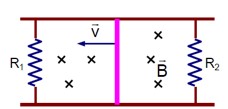A conducting bar of length L is free to slide on two parallel conducting rails as shown in the figure. Two resistors R1 and R2 are connected across the ends of the rails. There is a uniform magnetic field pointing into the page. An external agent pulls the bar to the left at a constant speed v.
The correct statement about the directions of induced currents I1 and I2 flowing through R1 and R2 respectively is:
A conducting bar of length L is free to slide on two parallel conducting rails as shown in the figure. Two resistors R1 and R2 are connected across the ends of the rails. There is a uniform magnetic field pointing into the page. An external agent pulls the bar to the left at a constant speed v.
The correct statement about the directions of induced currents I1 and I2 flowing through R1 and R2 respectively is:
Option 1 -
I1 is in anticlockwise direction and I2 is in clockwise direction
Option 2 -
Both I1 and I2 are in anticlockwise direction
Option 3 -
Both I1 and I2 are in clockwise direction
Option 4 -
I1 is in clockwise direction and I2 is in anticlockwise direction
-
1 Answer
-
Correct Option - 1
Detailed Solution:Kindly consider the following Image
Similar Questions for you
These two are varied terms, similar in their functioning but differ in their output. Inductance stores energy in the magnetic field to oppose the flow of electric current. And capacitance stores energy in the electric field in order to oppose the flow of voltage through the device. Capacitance is measured through the SI unit Farad (F).
While both of them oppose the flow of electric current, the key difference lies in their energy output. In the case of resistance, energy is released in the form of heat. On the other hand, inductance stores energy in its magnetic field and doesn't waste it.
The name of this SI Unit Henry is derived from the name of the scientist who discovered the concept of inductance and electromagnetic induction, Joseph Henry. He was a scientist from America who supported the principles of Faraday and helped in bringing a revolution in the field of modern physics.
at
and
The direction of induced emf is to oppose changing flux.
Taking an Exam? Selecting a College?
Get authentic answers from experts, students and alumni that you won't find anywhere else
Sign Up on ShikshaOn Shiksha, get access to
- 66k Colleges
- 1.2k Exams
- 680k Reviews
- 1800k Answers


